Text
Sweet, Sweet Chicago! Organic Spices for Summer Fruit
“What Else You Got?”

After I have gotten to know my hosts in any given country well enough, I have been known to go with them into their kitchen/restaurant and study the difference spices that they have and use regularly. Many times, this would become a creative event where we would play with different flavors and create special dishes.

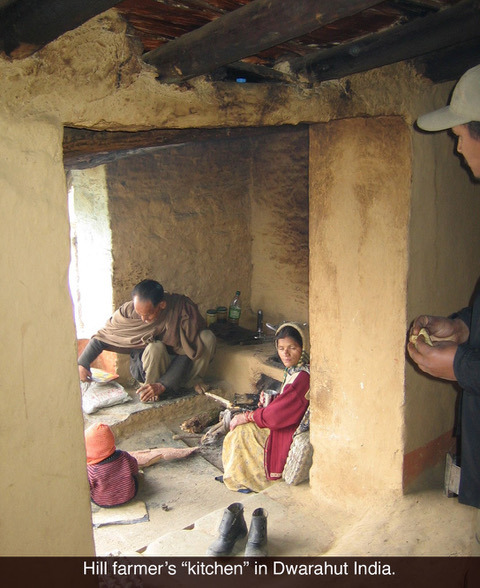
Now that we are well into summer, one such memory comes to mind. I was not in some exotic place far away, but in “My Kind of Town”,Chicago! This was several years ago, when all of us organic industry baby boomers were in attendance at a trade show. We had walked all day at the trade show for what seemed several miles on concrete floors, studying new products or selling our wares. We decided we earned the night out and would have to suffer by looking for the best blues clubs that Chicago had to offer. Kingston Mines, Blue Chicago B.L.U.E.S. Bar; yes someone had to do it. Not only was the music great, but the evening was special. They were inviting folks from the audience to come up and sing as well. We were all so young in this fledgling organic industry that it was quite like a family.It was a blast.Since the trade show was in the summer, the fruit was plentiful.Even though we were partaking in adult beverages, we could not completely debauch ourselves. As we were in the natural and organic food industry. we were carrying a backpack of fruit with us for snacks. Being in a high state of joy, I determined the fruit deserved a heightened state as well! So, an inquiry went out through our waiter to the kitchen; “do you have any cinnamon? sugar?” We were brought various spices so the apples and peaches were sliced and dipped in the spice. Again, we beckoned the waiter, “what else you got?” This became a side show for all of the adjacent tables, and the results were unanimous… this was pretty damn good!

I have tried to emulate the basic recipe that we ended up with that evening. I fondly call it Chicago Spiced Sugar. I actually keep a batch in my kitchen and use it as a general baking spice, but it is great on fruit. One of my favorite simple desserts is to sauté peach slices in coconut oil with a little maple syrup and the Chicago Spiced Sugar. Or simply try it on some buttered toast!

Recipe Time!
Chicago Spiced Sugar
HQOX Organic Allspice Ground - ¼ Teaspoon
HQOX Organic Cinnamon Ground – 1 Teaspoon
HQOX Organic Cloves Ground – ¼ Teaspoon
HQOX Organic Ginger Ground – ½ Teaspoon
HQOX Organic Nutmeg Ground – ¼ Teaspoon
Organic Cane Sugar – 1 Teaspoon
A few drops Organic Vanilla Extract (optional)
0 notes
Text
Southern Fried Chicken


I grew up in New Jersey so the term “southern fried chicken” was only partially known to my ears… the fried chicken part of it. I am a second generation American. That meant, as a boy, my family mostly ate what was cooked at home. So “going out to eat” was a big deal. Second best just might have been a big “take out” bucket of chicken that was devoured while gathered in front of the black and white television!

That bucket came from the restaurant chain whose motto was “Don’t cook tonight… call Chicken Delight!” Mmmm, Chicken Delight, with its delectable, wrinkly crispness and flavor overload that was probably due to the amount of fat that it was cooked in! But back then, us youngsters could probably eat almost anything and our bodies would deal with it. However, a few years ago when I was asked to create an Organic Southern Fried Chicken seasoning, I did not turn to my fanciful memories of youth and Chicken Delight. I binge researched the historical cooking and frying of chicken to get into the “how do I make the best” zone. That’s what I wanted the High Quality Organics Southern Fried Chicken seasoning to be.
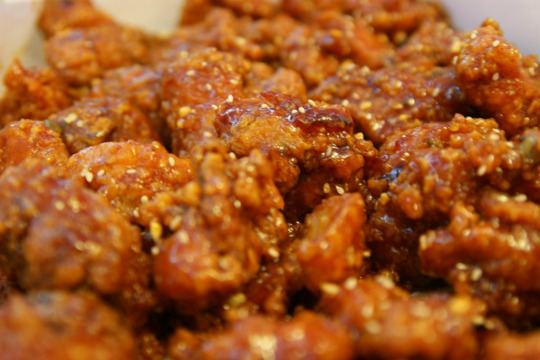
Simply put, fried chicken is so darn good, it exists in cuisines all over the word. Italy has pollo fritto, crispy fried chicken is a standard in Cantonese cuisine of China. Korean fried chicken is fried twice, they like it so crisp! India has chicken pakora; a pakora being a type of fritter. Speaking of fritters, that is a perfect segue to fried chicken here in the US. Scottish immigrants, came to North America in the 1700s, after being evicted from their land that was confiscated for sheep grazing! The Scots called fried foods, fritters. Chicken was mostly prepared in this manner; fried but without any seasoning. Many early Scottish immigrants had humble beginnings as indentured servants, and life was very simple. Chickens were small and relatively easy to keep. Therefore, chicken was a regular entrée on the menu. Chicken fritters became popular in the south as these early Scottish settlers spread out their residency in the southern states.
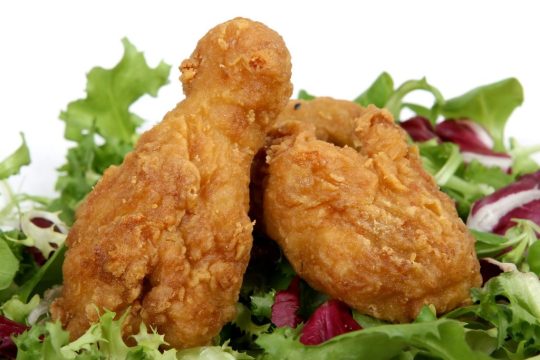
Southern Fried Chicken as we know it, developed due to the early African immigrants. Unfortunately forced to come, the diversified African cultures had an extensive knowledge and capability with foods and spices. Spices were known from the trade routes in and around Africa, and foods…. well here is a list we can attribute to the African immigration – Cala or rice cake, Calalu, a soup similar to gumbo, Coffee, Cowpeas, Cayenne and Paprika type pepper, Goober or peanut, sorghum and millet, Gunger or Gingerbread, Tshimbolebole or Jambalaya, red rice, Guimyombo (get it, Gumbo) or Okra, Cola nitida or Kola Nut (wouldn’t have Coke without it!) and Sesame seeds. Some researchers believe Africans first cultivated rice in America. Early African Americans took dried corn kernels and made grits.

Traditional Southern Fried Chicken was influenced by the Scottish fritters, but were chicken pieces, bones intact, dipped in batter and spiced with paprika, pepper, onion, garlic and other spices brought over from West Africa. The battered pieces were then dropped in hot oil or lard. There are great stories of entrepreneurial African American women selling fried chicken in the 1730s. Hannah Glasse published “The Art of Cookery Made Plain and Easy” in 1747. “To Marinate Chickens,” was a recipe in the book for flour-covered pieces of chicken to be fried in pig lard. Brown fricassee, was a recipe where chicken cubes are dipped in egg, seasoned breadcrumbs, and then fried. Historians attribute these recipes to the African Americans in the south.
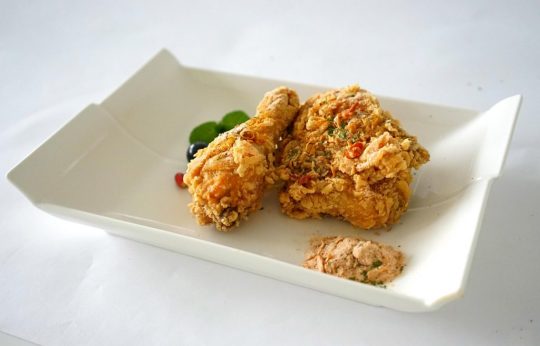
Healthy Southern “Baked” Chicken Serves 2-3 Ingredients 3 chicken thighs 1 egg 1/3 cup all-purpose flour 1/3 cup bread crumbs 1 Tbsp. HQOX Southern Fried Chicken Seasoning 1/2 teaspoon HQOX Southern Fried Chicken Seasoning 1/4 cup olive or vegetable oil
Directions Heat oven to 350 degrees F Mix flour and 1 Tbsp. seasoning in a plate or bowl Place bread crumbs in a separate plate or bowl Place eggs and beat in a separate bowl Cover the chicken piece by piece in the flour, then dip in the egg, last in the bread crumbs, until pieces are coated evenly. Pour the oil into a 9x13 inch baking dish. Place chicken in the dish Sprinkle 1/2 teaspoon seasoning evenly over chicken Bake in preheated oven 30 minutes, turn and bake for another 30 minutes Remove from oven and drain.
1 note
·
View note
Text
Jerk Chicken Recipe
My Big Jerk (Chicken) Story By Jeff Helfand

What do I know about cooking, recipes and organic ingredients? Not a lot but I’m learning fast! You see, up until last year I was much better known as an e-commerce industry specialist within the consumer electronics, automotive and sporting goods world.
Most recently I was working for Tesla and it was during this time that I met Jerry Tenenberg, cofounder of High Quality Organics. Jerry has been developing the world of organic spices and herbs since the 1970s. Through Raju Boligala (HQO cofounder & CEO) I learned HQO was readying to launch HQO Express. The vision to empower boutique food makers and artisan chef/restaurateurs to use globally grown organic spices made into safe and certified ingredients in the United States resonated with me. Indeed, this has been a fascinating introductory journey and being surrounded by people who really care about our farmer families, know them personally and genuinely believe in HQO’s mission has nourished my soul. I hope HQO Express conveys this meaning to you and makes your life and business better, as well.
In my digital travels to become a “spice guy”, I was reminded of a trip my wife and I took to Jamaica in the early 90’s, specifically eating at a roadside smokehouse in Montego Bay called The Pork Pit. We loaded up on their Jerk chicken. Two decades plus and I still remember how good it was!
So….I asked Jerry, “do you have a Jerk blend?” He said, of course…but like all chefs…the recipe is secret. Sure enough, a few days later, a stealthy blend of Jerk spice arrived in the mail. My wife and I took a big sniff and instantly were knocked out by the pungent sweet and spicy aroma. Well with great weather in hand for the weekend, I prepared my smoker with a fresh load of mesquite charcoal and got it to a consistent 250 degrees F and smoked/cooked it for over four hours.To which we made a marinade to cover about four pounds of chicken:
A 1inch piece of freshly peeled Ginger 3 Cloves of peeled Garlic A cup of rough chopped Scallions 3 Tablespoons of extra virgin Olive Oil 3 Tablespoons of Water 1/3 of a cup of Soy Sauce 1/8 of a cup of pickled Jalapenos peppers The juice of 1 whole Key Lime
3 Tablespoons of Jerk Spice. See below for a simple Jerk seasoning using HQOX spices:
2.5 Tbsp organic sugar
2 teaspoon sea salt
2 teaspoon organic pepper ground
1 teaspoon organic all spice ground
1 teaspoon organic cinnamon ground
1 teaspoon organic cumin seed ground
1.5 teaspoon organic garlic granules
1.5 teaspoon organic ginger ground
1.5 organic onion minced
1 teaspoon organic oregano
1.5 teaspoon organic paprika ground
1 teaspoon organic thyme leaves
1.5 organic chili ground
.5 organic cayenne ground (+/- cayenne to head desired)
This spice mix makes 1/2 cup or enough meat for 8 lbs
Recipe per Lb of meat:
1/8 teaspoon per lb - mustard 1/2 teaspoon per lb - orange juice 1/2 teaspoon per lb - lemon juice 1 Tbsp. per lb - Spice mix 1 Tbsp. per lb - Oil
Mix all ingredients in a bowl and use as a rub on meat, or as marinade.

Throw all of the above into a blender/food processor and let it go crazy for a minute….
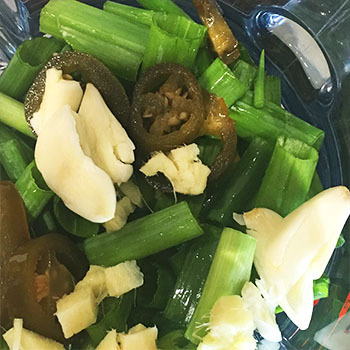
You should have a resulting liquid that smells and tastes much better than it looks.

Grab two freezer bags, divided and place your raw chicken into the bags. Pour in the greenish marinade and let the chicken soak overnight or whatever time permits. (If you can’t at least afford a couple of hours, shouldn’t you really be ordering pizza?)
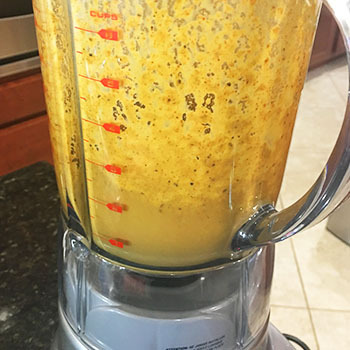
When you chicken is properly marinated, put it on your smoker or grill and cook to a safe temperature (165 degrees F).
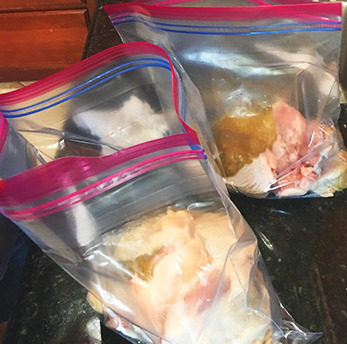
Pair your jerk chicken with some Caribbean influenced rice, beans or potatoes. Put on some flip flops and Reggae music.

Then, enjoy. Ya man!
0 notes
Text
The Wooden Spoon
Watch our founder Jerry Tenenberg and Chef Jesse Paul of The Wooden Spoon discuss the importance of quality, organic ingredients that make a dish memorable. We also get to visit Jerry's home garden and watch him and Jesse taste test oroblanco grapefruits and golden nugget tangerines!
“You put so much time into the soil, into growing the vegetables and the herbs. I think as Chefs, we have a due diligence to continue that once it comes to our doorstep, to treat it the right way and put as much love into it as we can …” Jesse Paul – The Wooden Spoon Restaurant - Escondido, California
youtube
0 notes
Text
Black Peppercorns

Ayurveda is a holistic system of health and healing. It is thousands of years old, with it’s roots in Southern India. The ancient texts explain that Ayurvedic knowledge was given by God to the sages and then to worthy practitioners. The oldest known reference to pepper is the Sanskrit word “pippali” which appears in these texts. However, it is actually the word for Long Pepper (piper longum), a different fruit and much hotter than the round black pepper we know and use today. Long pepper came to Greece in the sixth century BC., and initially was used medicinally rather than a spice. By the time of the Roman Empire, Round Black Peppercorns (piper nigrum), the spice we use today, and Long Pepper were both known and used. The Romans referred to both as “Piper” and thought both came from the same plant. That is where the confusion comes from.
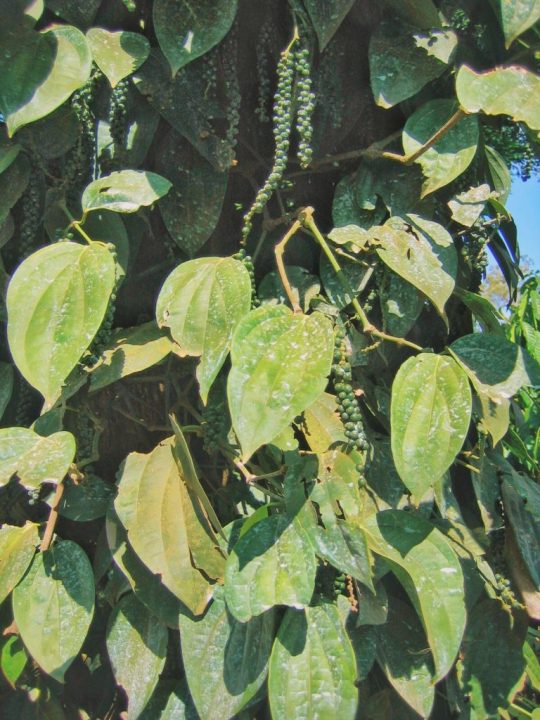
By the 1300’s Round Black Pepper became the spice of choice in Europe. The growing demand was the impetus that created naval trade routes and discoveries. Although pepper is native to Southeast Asia, southern Thailand and Malaysia, the most important source through the 19th century had been the Malabar Coast, in Kerala, India. “Malabar Pepper” had become synonymous with the best and most flavorful of all the black pepper. Perhaps that notion came from the trade control and influence of England during the 1800s. But no doubt there are wonderful varieties of black pepper on the Malabar coast. Through selective breeding, farmers developed the plant and fruit traits they needed to have consistency in their crop. Due to the many centuries of production in Southern India, the black pepper varieties and growing conditions became optimized.

Today, our farmers have identified the flavor, color, size, and weight of ideal peppercorns and the necessary growing conditions, so that we can produce the quantity and quality consistently from an expanded area in southern India.
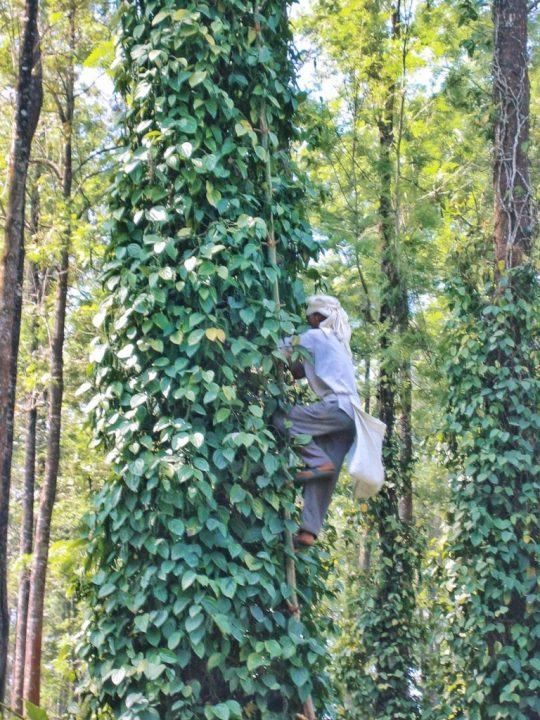
At the end of the growing season, we travel to Kerala, the southern state in India, and test the fresh pepper fruits for sweetness and ripeness. The pepper is handpicked from the vine (by very adept acrobatic climbers!) and spread out to dry for several days on concrete platforms. The fresh green fruits shrivel and dry to become black peppercorns!
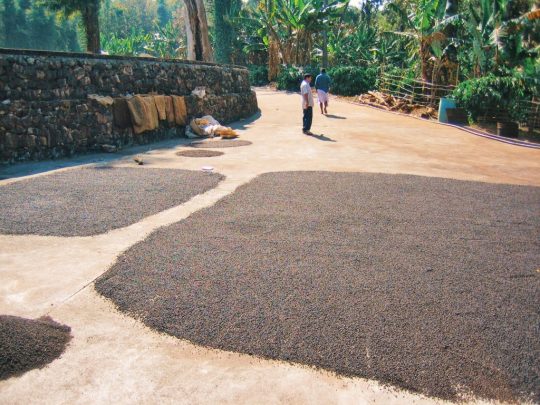
Awesome Garlic Pepper Burgers 1 Tbsp Garlic Pepper ½ teaspoon Basil Leaf ½ cup Thousand Island Dressing 5 ounces sliced bacon (optional) 1 pound ground beef (can blend 50/50 with ground sirloin) 1 tablespoon unsalted butter, melted 3 slices sharp cheddar cheese 3 hamburger buns, split and toasted 3 iceberg lettuce leaves 3 slices of tomato (thin) 3 slices of red onion (thin)
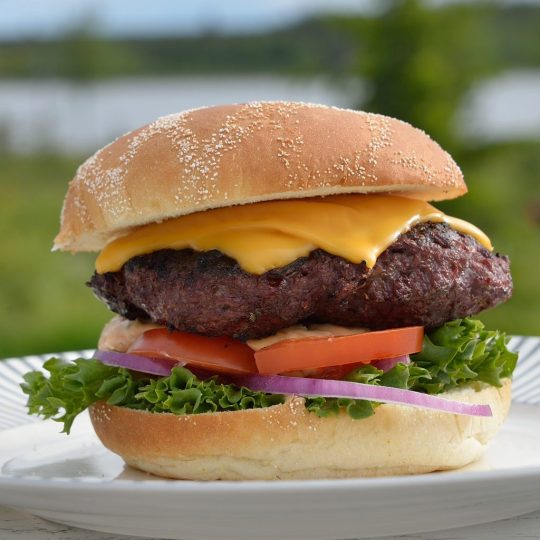
Instructions:
Pre Heat Grill to high or Stove Top to medium high heat. Cook bacon over medium high heat, turning once, ‘till crisp, about 6 min. Drain well. Cut bacon into large pieces. If cooking burgers on stovetop clear pan or start new pan to medium high heat. Very gently mix the ground beef, directly from refrigerator, with the garlic pepper and basil. Form the meat into three patties, just over 1 inch thick. Place burgers on grill or pan and brush with some of the melted butter. Grill over high heat or pan fry over medium high heat. Cook 3-4 minutes each side for medium-rare meat, turning once or twice brushing occasionally with butter. Add a cheese slice for last minute.
0 notes
Text
Jerry travels to Guatemala
We want to send our thoughts and prayers to all those affected by the recent eruption of the Fuego volcano in southern Guatemala. The same force of nature that can be so destructive is also what has made this country so amazingly beautiful.
There is something very powerful in the air and in the soil of this, the geographic center between the Americas. Guatemala is a very agriculturally diverse country with five distinct eco systems. It’s typical to see several crops, such as corn, grain, beans, coffee, fruits and vegetables, grown on an individual farmer’s land.
Much of the farming is done on the slopes and valleys of this rugged country. I’ve experienced inspiring moments every time I’ve come here. The folks I have worked with are tenacious and committed to their craft.
My travels often take me to the Alta Verapaz region in central Guatemala, with fertile hills and mountains. Several altitude changes create a climate range from hot to cool and humid. Coffee, allspice and cardamom thrive in this area with its lush evergreen tree carpeting. Allspice, the dried berry fruit of an evergreen, can grow on lone trees with individual farmers or in groves as seen here.
Cardamom is a primary crop from this area. It’s a beautiful crop with individual stands of chutes spaced about 6 feet apart.
Cardamom pod production is dependent on a reliable amount of rain mixed with regularity of sunshine. The pods are harvested by hand three times each year. The pods grow at the base of the plant and are a vibrant green at time of harvest.
Traditionally, cardamom is grown under the canopy of old-growth forests. The chemistry and physical characteristics of the soils are ideal. At High Quality Organics, we work with the organic farming groups in Guatemala to protect the old-growth forests with sustainable growing techniques and a strong steady price that maintains the economic validity for the crop. The harmony and balance of organic farming along with the sustainable aspects, create an environment that is more immune to many of the disease and insect problems that plague the conventional crops as well.
Again, our best wishes to everyone in Guatemala and we hope for a rapid recovery.
Here is a simple chai recipe that utilizes the great ingredients from High Quality Organics.
For a strong flavor use 1 tablespoon per pint of liquid in any baking application. A half teaspoon in a smoothie is really good!
Easy Chai Spice Recipe:
1 Tbsp ground cinnamon
1 teaspoon ground ginger
1/2 teaspoon ground cardamom
1/8 teaspoon ground allspice
1/8 teaspoon ground cloves
1/8 teaspoon ground nutmeg
1/8 teaspoon ground black pepper (optional for more spiciness)
0 notes
Text
Jerry travels to China
[vc_row][vc_column][vc_column_text]When I first began to travel, I was continually awestruck. Especially because I had never been outside of the United States, so every new culture was a wonderland! It was a joy to meet new, very sweet people in very remote parts of the world. To this day I consider them all friends. At first, however, having the need to communicate and not speaking the language compelled me to adopt certain methods to gain perspective on the culture and learn where to begin our journey together. A method that became a hobby was to learn about the history of where ever I had traveled to. How far back did their family ancestry go? How long did their family work the land and for how many generations? Why did people originally settle in the area and what held them together? And most fascinating to me - were there any old or ancient relics still in existence that I could go to see? When I first went to China, for example, the history in cities like Shanghai, Xian or Beijing was dazzling! But when I journeyed east to visit growers in the Shandong Provence, they took me high into the mountains. There I saw a unique tree with tremendous character. The “Scholar Tree” is valued for its longevity and welcomes all visitors who make it to the mountain top![/vc_column_text][/vc_column][/vc_row][vc_row][vc_column width="1/2"][vc_single_image image="165" img_size="large"][/vc_column][vc_column width="1/2"][vc_single_image image="166" img_size="large"][/vc_column][/vc_row][vc_row][vc_column width="1/2"][vc_column_text]While there were not many temples in the cities or low lands, discovering a Taoist temple high in the mountains was thrilling! When my companions through an interpreter, shared details of history or legends, it provided insight into a people that were very visual and assigned deep meaning to almost everything. So, my descriptions of what I wanted to share with them became very visual and meaningful! One really touching memory was when we were traveling north of Chengdu, near the Panda Reserves and we met with villagers on a project for medicinal plants, teas and herbs. I had studied the area and had my usual litany of questions ready to ask. But I was blown away when we walked into a very simple home and found one of the most delectable gourmet spreads of food ever laid before my eyes. You see they had heard an American was coming and he was vegetarian, so they asked all of their neighbors to contribute any vegetables, beans or edible plants that could go into a meal for the guest. I include a picture here, which is only about a third of what was on the table! They cooked it all on the "kitchen stove" - a huge wok on an open fire comprised the entire kitchen! And the best part were the herbs and seasonings that flavored everything dish, all local and indigenous to the area. High Quality Organics touches the life of 18000 farmers worldwide. And we don’t forget that they all touch our lives as well. I am grateful to know this first hand. We have 3 decades of experience, maximizing the quality of our products. We hope that you our customers, can see, taste and appreciate all the love and dedication, from many, many farmers and their families and all of us at HQO Express, that goes into every ingredient.[/vc_column_text][/vc_column][vc_column width="1/2"][vc_single_image image="167" img_size="large"][/vc_column][/vc_row]
0 notes
Text
Sweet Cinnamon
Earliest records find Cinnamon arriving in the Mideast over 4000 years ago. The word is a derivative from Hebrew. It is one of the reasons trade routes from Asia were established on the land and sea.
Most of the spice we call cinnamon is “Cassia” from China, Indonesia and Vietnam. Cassia is the bark harvested from trees, branches and shoots from 5 years to 25 years old. New trees can regenerate from the roots.
Farmers remove the bark in pieces, and dry it in the sun for several days, causing the bark to curl into quills. The quills are sorted for quality and end use; chips, sticks or powders.
Our work with Cassia over the years has been to develop consistency regarding oil content, flavor, aroma and specification that will deliver the best of overall characteristics.
This endeavor takes us to all sources. Here, I travelled north on the island of Sumatra Indonesia, through Padang on the western coast. Life is simple and sometimes, as you can see in this photo, so is transportation!
We all want to do something we enjoy that makes us proud. We desire to be recognized and appreciated for what we do and know that our efforts are meaningful. And, we want to meet our own and our family’s needs.
Yes, HQO’s efforts help with schools, medicine and the overall increase in quality of life. Our focus and appreciation help maintain the consistency and reliability of all the products, like cinnamon (cassia), that we bring to our customers. Personally, my greatest memories are of the love and care we are given by the villagers and knowing to this day, that I have many true friends around the world. Why, these folks here at a manager’s home were so gracious, they even put up with my singing!
1 note
·
View note
Text
Persistence in Egypt
At High Quality Organics, we started with just an idea: 100% Organic Ingredients. The secret of our success… persistence. A great historical example of persistence exists in Egypt.
The Greek word apothēkē, which means barn or storehouse and is the predecessor of the word apothecary, comes from an ancient name for an area of the Nile River Valley in upper Egypt. In ancient times this region is where agricultural products were stored and warehoused, including an abundance of locally farmed herbs and botanicals. These were then transported and traded in the major cities of the day, such as Jerusalem. The Nile Valley was quite a happening place!
Ancient Egyptians farmed the fine silt on the banks of the Nile River. Annual rains in Ethiopia to the south would cause flooding all along the Nile as it flowed north for 600 miles. This yearly cycle, replenished the perfect organic growing medium needed to grow crops.
In 1843 it was decided to build diversion dams across the Nile near Cairo, to regulate navigation of the river. By 1970, the Aswan High Dam, over 500 miles south of Cairo, was finished and completely eliminated the flooding cycle. From then on, farmers would depend on man-made canals carrying water depleted of minerals and nutrients for crop irrigation. Fertilization would have to come from outside sources and usually synthetic.
When I first went to Egypt many years ago, I was disheartened to find generally very poor agricultural processes. But there was a light; a few farmers either adopted natural methods handed down from previous generations or were willing to adopt methods I had learned that I could share with them.
I’ve included some fun photographs from those early days. You can see soil that has been piled between the palms that farmers would layer with the manure from their livestock. This crude "compost" was carried by any means (in this case by donkey) and placed strategically by number of piles per row. You can see we had some good results with the chamomile and mint in the picture of the piles. My rule of thumb grew to become: one cow would supply enough manure to mix with soil to replenish one acre of land per year.
Now let’s fast-forward five years or so. The cow herd got a little bigger and the composting operation was of size to really change the Egyptian landscape and provide the volume of product we had promised to our customers! Our relationship with the farmers and the organic methods employed then and now are so important to mitigate the challenges faced in Egypt. And the story is similar in many places around the world. The steady effort to find opportunity and solutions to evolve organic agriculture will increase food production and quality of life from farm to table.
- Jerry's Organic Farm
0 notes
Text
Early Agriculture in Galilee
Traveling north along the Jordan River Valley, we rise to a high ridge overlooking the Sea of Galilee, situated between the Golan Heights and the Galilee region. The Jordan River Valley was created by the separation of the African and Arabian Plates. Artifacts such as jewelry and tools, burial grounds, and the remains of dry-stone foundations of round huts have been found in the area. The Natufian people existed from around 12,500 to 9,500 BC. Originally hunter-gatherers, the Natufian settlements may have been some of the oldest in the world. And, their cultivation of cereal grains such as wheat and rye, also demonstrate the earliest evidence of agriculture in the world!

The “Way of the Philistines” or the modern name, Via Maris, was an ancient trade route through the area; the most important route from Egypt to Syria (the Fertile Crescent). Anatolia and Mesopotamia; modern day Iran, Iraq, Israel, Turkey and Syria; all connected through this Via Maris or "Way of the Sea."
Herbs such as parsley, cilantro, rosemary, basil and mint are traditional ingredients in the diverse cuisine of the Galilee and are the products we came here to see. Today the farming is very sophisticated and efficient.

A century ago this land was barren and dry. The irrigation and logistic methodologies are the most advanced in the world. The farmers have been wonderful to work with as they embrace sustainability and are dedicated to organic production.

Fish and meats are prepared with these herbs. Baked Tilapia is served with vegetables and Tahini, or sesame paste. The Galilee is known for wine, olives, dates, pomegranates, and culinary herbs as mentioned. Meat stew, kebobs and fish and prepared with herbs.

All over Israel tahini is a mainstay. It’s served as a dip with pita bread, or as a sauce for fish, falafel, beef shawarma, hummus, baba ghannouj and other Mediterranean side dishes.
Here is a great recipe that can support chicken or fish. Specifically is for chicken, this will be delicious served over rice.
Tahini Sauce
1/3 cup HQOX sesame seeds
1-2 Tbsp olive oil

Instructions:
Toast sesame seeds on medium heat in a pan for a few minutes until they turn a golden color.
Blend sesame seeds in a blender and slowly add 1 Tbsp of oil at a time until you are able to drizzle the tahini.
Marinated Tahini Chicken
1 1/2 lbs or 8 boneless chicken thighs
1/3 cup tahini paste
1/4 cup olive oil
1 tbsp HQOX minced onion
1 tbsp garlic minced
1/2 teaspoon salt
1/4 tsp HQOX crushed red pepper
1 1/2 teaspoons HQOX parsley
2 teaspoons HQOX rosemary
3 tbsp water
Juice from 1 small lemon
2 tbsp plain yogurt
1 tbsp water

Marinade: Combine tahini, oil, onion, garlic, salt, red pepper, rosemary, water and lemon juice. Mix well.
Separate 4 tablespoons marinade and add yogurt and water. Mix well and refrigerate.
Place the chicken in a large ziplock bag and add marinade. Seal the bag. Rub the marinade to cover the chicken. Refrigerate overnight.
Heat skillet or grill to medium high, and coat with oil or spray. Remove excess marinade from chicken and cook 2-4 minutes per side depending on thickness of chicken, covered. Throw the excess marinade in the ziplock away.
Use the set aside ¼ cup of marinade mix as a sauce when serving over rice or with sides.
0 notes
Text
It's pancake time!
[vc_row][vc_column][vc_single_image image="93"][/vc_column][/vc_row][vc_row][vc_column][vc_column_text]It's recipe time again! And mmm...pancakes. It's difficult to go wrong with pancakes on these cold Fall and soon-to-be-winter mornings. Especially if you can add our amazing organic cinnamon to the batter. We love that you can increase your zinc (and the general nutritional content) by using organic whole wheat flour in these. There is nothing quite like a fabulous pancake breakfast with an added nutritional twist. What are you having for breakfast?
Whole Wheat Pancakes
Recipe from the Organic Center on Nov 30, 2017
Piping hot pancakes may be one of the best breakfast traditions of all time. Try this healthy but delicious spin on an old classic by using whole-wheat flour and remember to increase your nutritional content even more by choosing organic when purchasing your flour.
The Science
A recent study, published in the scientific journal PLOS One found that wheat from organic farms had higher concentrations of Zinc than wheat grown conventionally. The study compared levels of the important nutrient Zinc (Zn) in wheat from 30 organic farms and 30 conventional farms. They found that Zn concentrations were higher in the wheat grains from organic farms. Organic wheat also had higher levels of phosphorus, nitrogen and sulfur.
The Recipe
Photo credit: Emma
Ingredients
2 cups organic whole-wheat flour
2 Tbsp. organic brown sugar
1 Tbsp. baking powder
1 tsp. salt
1 ½ cups 2% organic milk
1 large organic egg
4 Tbsp. organic unsalted butter, melted, plus more for frying
1 ½ tsp. organic vanilla extract
Directions
Combine the flour, brown sugar, baking powder and the salt in a mixing bowl and set aside. In the microwave or on the stovetop, heat the milk until it is warm but not hot. Once warm, remove it from the stove or microwave and add in the melted butter, egg and vanilla. Whisk until well blended. Pour the milk mixture into the flour mixture. Using a fork, mix until only small lumps of flour remain. Note: Do not over-mix the batter. It should not be completely smooth. Heat a large frying pan over medium heat. Once it is hot, coat the bottom with butter. Scoop ¼ cup of the batter into the middle of the frying pan and cook until little bubbles begin to rise and pop in the center of the pancake – about 2 minutes. Flip the pancake and cook on the other side for another 2 minutes or until lightly browned and cooked through. Remove from heat and continue until you have used all of your batter. Makes 10 – 12 pancakes. Serve warm with maple syrup, powdered sugar, fruit or all by themselves.
[/vc_column_text][/vc_column][/vc_row]
0 notes
Text
Homemade Lemon Tea
[vc_row][vc_column][vc_single_image image="99"][vc_column_text]It's recipe time! Since many places are dealing with freezing (or below freezing) temperatures, a recipe for hot ginger lemon tea seems to be just the thing we all need. If you can't find fresh ginger in your area, our excellent fine ground ginger makes a lovely substitute. We love the research showing that organically grown lemons are more energy efficient and environmentally sustainable. Somehow that makes this tea all the more enjoyable. Jump in with this one and enjoy a bright, invigorating citrus drink to combat the gloom of winter.
Hot Ginger Lemon Tea or Refreshing Ginger Lemonade
Jan 20, 2018
This is a simple and delicious beverage that you can enjoy year-round regardless of whether it is January or June or you live in Canada or Florida. All you need are four ingredients to get you through the winter and usher in the summer. When buying lemons for this beverage, be sure to choose sustainably grown organic lemons!
The Science
A study published in the Journal of Environmental Management compared the sustainability of organic and conventional lemon and orange groves on the island of Sicily. Using a lifecycle assessment approach, the authors compared organic and conventional orchards for energy usage, environmental sustainability and economic sustainability over a 50-year period. They found that for both lemons and oranges, but particularly for lemons, organic production systems were more energy efficient and had lower environmental impacts. They also found that the conventional management systems were more expensive than the organic systems.
The Recipe
Ingredients
4 cups of water
¼ cup of fresh squeezed organic lemon juice
6 tablespoons of organic honey
2 inches of organic ginger, peeled and thinly sliced
Directions
In a sauce pan, combine water and ginger and bring to a boil. Reduce heat to low and simmer, covered for 30 minutes (simmer for up to 1 hour if you prefer a spicier beverage). Remove the sauce pan from the heat and discard the ginger slices. Add honey and stir until dissolved. Then add the lemon juice. If you prefer a sweeter drink, add more honey to taste. If you are drinking this as a hot tea, serve immediately. If you are serving as lemonade, chill in the refrigerator for at least one hour (and up to three days). Garnish with a lemon and serve on ice.
[/vc_column_text][/vc_column][vc_column][/vc_column][/vc_row][vc_row][vc_column][/vc_column][/vc_row]
0 notes
Text
How is organic food processed?
As our next installment to learning about what makes organic food different, we are going to look at the question of how is organic food is processed. Have you ever wondered about possible processing differences between conventional and organic foods? It turns out that the answer is quite a bit! Organic processing requires rigorous standards to ensure an excellent and consistently high-quality product, and the HQO Express family is thrilled to consistently hit those standards and surpass them. To learn more about the specifics on organic processing, we visited the Organic Trade Association.
How is organic food processed?
Organic foods are minimally processed without artificial ingredients or synthetic preservatives to maintain the integrity of the product that began with practices on the farm. For example, the use of GMOs is prohibited during the production and processing of certified organic products. A rigorous certification process, including periodic testing, is required. Also, irradiation is prohibited in organic processing.
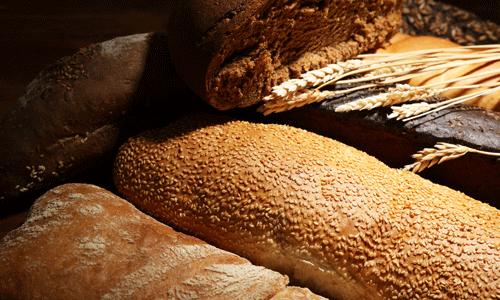
Organic food must be processed in an operation that has been certified to organic standards, with special steps taken to make sure the organic ingredients are not co-mingled or contaminated with non-organic materials.
National organic standards set out the methods, practices and substances used in producing and handling crops, livestock and processed agricultural products. The standards include a national list of approved synthetic and prohibited non-synthetic substances, not only for organic production but also for processing.
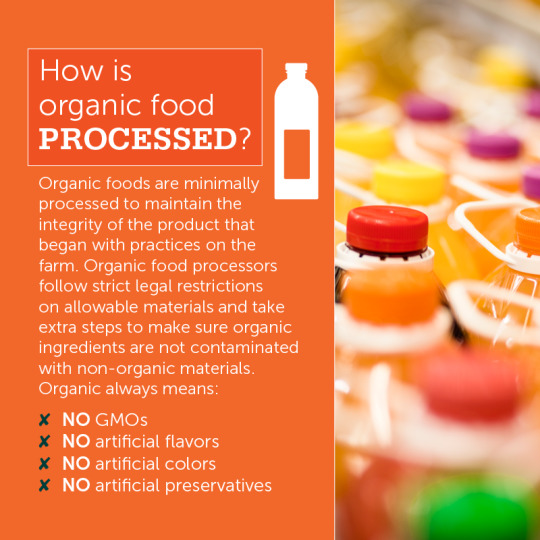
0 notes
Text
A Florida Walmart Supports Organic
Wow! We love this story. It looks like a Walmart in Florida has turned its back on the typical in-store restaurants and is instead teaming up with the organic fast food restaurant known as Grown. That's a big change for a large company - a company with a great deal of influence. This certainly speaks to the trend that consumers want organic. We'll definitely be interested to see what other big-box locations choose to do moving forward.
A Walmart shunned McDonald's for a new organic fast-food chain

Dennis Green
Aug. 25, 2017, 1:48 PM
A scene from the new Grown store inside the Orlando, Florida Walmart Supercenter. Walmart
While many Walmart stores have some type of food component, it's usually a McDonalds or Dunkin Donuts, a location in Orlando, Florida just went in a different direction.
Instead of the usual fare, it instead has a new location of the fast food chain Grown.
Grown focuses on organic and healthy food, with average meals costing in the mid teens. Its counter-serve fast-casual style, and you choose a protein, grains, greens, and other ingredients that can be served in a bowl, wrap, salad, or sandwich.
There's a large variety of mains to choose from, including salmon, falafel, shrimp, brisket, and more. Grown also serves breakfast in the morning, and smoothies and juices all day.
The restaurant has one other location in Florida, down in Miami, and one other location in the bookstore of Wesleyan University in Middletown, Connecticut. It was started by Shannon Allen, the wife of ex-pro basketball player Ray Allen.
Walmart has recently been making big strides to court the health conscious consumer and the company has majorly revamped its organic food offerings. It's now become the biggest organic food slinger in the US.
This new restaurant is just another sign that the US' largest retailer is serious about serving these customers, and paying attention to customer's needs and demands.
0 notes
Text
Pondering a lasting legacy
What is our lasting legacy?
After inspecting seed crops like cumin and fennel in the surrounding valleys of the southwestern city of Burdur, Turkey, we decided to travel south towards the Anatolian coast. Here in the mountains we would find oregano and wild sage. We had taken this route many times, but today my companions asked if I would like to travel to see the ancient city of Perge. They did not have to ask twice!


Perge (pronounced pur-ga) was an ancient Greek city, whose presence dates back to the 13th century B.C. We arrived at a large site of ancient ruins about 10 miles east of Antalya on the coastal plain. A once sprawling metropolis with an acropolis (a citadel on high ground), a stadium, amphitheater, and bath houses; now lay in ruins from its glory 2,000 years ago.


A beautiful fountain had been constructed where artesian waters entered from a mountain slope and first flowed into the city. Water poured down from Kestros, the God of the river into a pool and then into the canal that flows through the city between the Roman columns that had been added to the Greek city, when Rome conquered in 180 B.C.
Perge had a unique character that had begun with the Greeks and continued to its peak in the second and third century of the Roman empire. It provided protection to anyone who entered its boundaries and all were treated with respect. Anyone could freely utilize any of the city’s features, including the bathhouses with their intricate stone fire chambers, that once heated the water in the bathing floor above, that has long since collapsed.

As I stood before this breathtaking view, I pondered what might have been considered a utopian city. All inhabitants were treated with dignity and it offered the finest theater, spas and culture of its day. But it also presented a strange juxtaposition. However magnificent this ancient city had been; it was now in ruins. It is amazing what people can build, and also impressive that this city’s legacy was one of harmony.

So I thought what would be our legacy? The day before I had witnessed the new growth of spring crops that would provide an abundance of sustenance and joy to many. I thought how fortunate we are to produce hundreds of different crops and products from thousands of farmer families around the world. We had embraced the organic alternative and eliminated toxic chemicals from the farming process. But I thought, most of all, we believe in what we are doing. We do it with a passion and are optimistic and excited about life. At High Quality Organics, we do what we do because it is right.
0 notes
Text
carbon-sequestration
Agriculture’s beneficial contribution to climate change
All the discussions on organic vs. non-organic products can be overwhelming! For most of us, the decision is driven by a variety of motivations one way or the other. Most of those motivations are personal in nature (cost, quality, and flavor being large factors). So it is incredibly interesting to find considerations outside of personal consumption that could impact this choice as well.The study below is absolutely fascinating. In a joint study between Northeastern University and The Organic Center, researchers found that organic agriculture may increase carbon sequestration in the soil, making it a critical choice for agriculture in the context of climate change.Breakthrough study shows organic cuts agriculture's contribution to climate change.
0 notes
Text
What does organic farming actually mean?
What does organic farming actually mean?
Have you ever wondered what makes organic farming different than conventional farming? Here at HQO Express, we are naturally passionate about all aspects of organic farming and would love to help you learn more. We believe in empowering consumers to make informed choices, and part of that is learning about what each label and process actually means. To this end, we are excited to showcase small "bites" of information where you can learn just a bit more about organic crops and how they work. To start, we love this brief overview from the Organic Trade Association:
How is organic food grown?
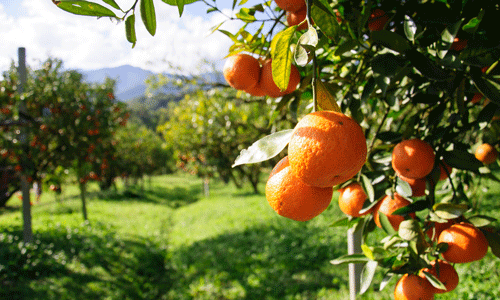
Organic agriculture, which is governed by strict government standards, requires that products bearing the organic label are produced without the use of toxic and persistent pesticides and synthetic nitrogen fertilizers, antibiotics, synthetic hormones, genetic engineering or other excluded practices, sewage sludge, or irradiation.
Guided by these and other standards, organic is the most heavily regulated and closely monitored production system in the United States.
Organic farmers understand that what you put into the soil has a profound impact on what you get out of it. That is why they rely on such practices as hand weeding, mechanical control, mulches, cover crops, crop rotation and dense planting, rather than toxic and persistent pesticides, herbicides, and synthetic nitrogen fertilizers, to enrich the soil in which they grow their crops.
They recognize that doing so provides plants with the nutrients they need to grow. Plus, it enables the absorption of major and micro-nutrients like Vitamin C, resulting in a higher nutrient content and often a better tasting crop.
It all starts with practices to help build healthy soils, which nurture the plants and help decrease the incidence of plant disease. In order to earn organic certification, land must be handled without prohibited materials for at least three years. With certification, organic farmers must develop an organic operating farm plan, which is overseen by their certification agency with annual third-party inspections.

0 notes